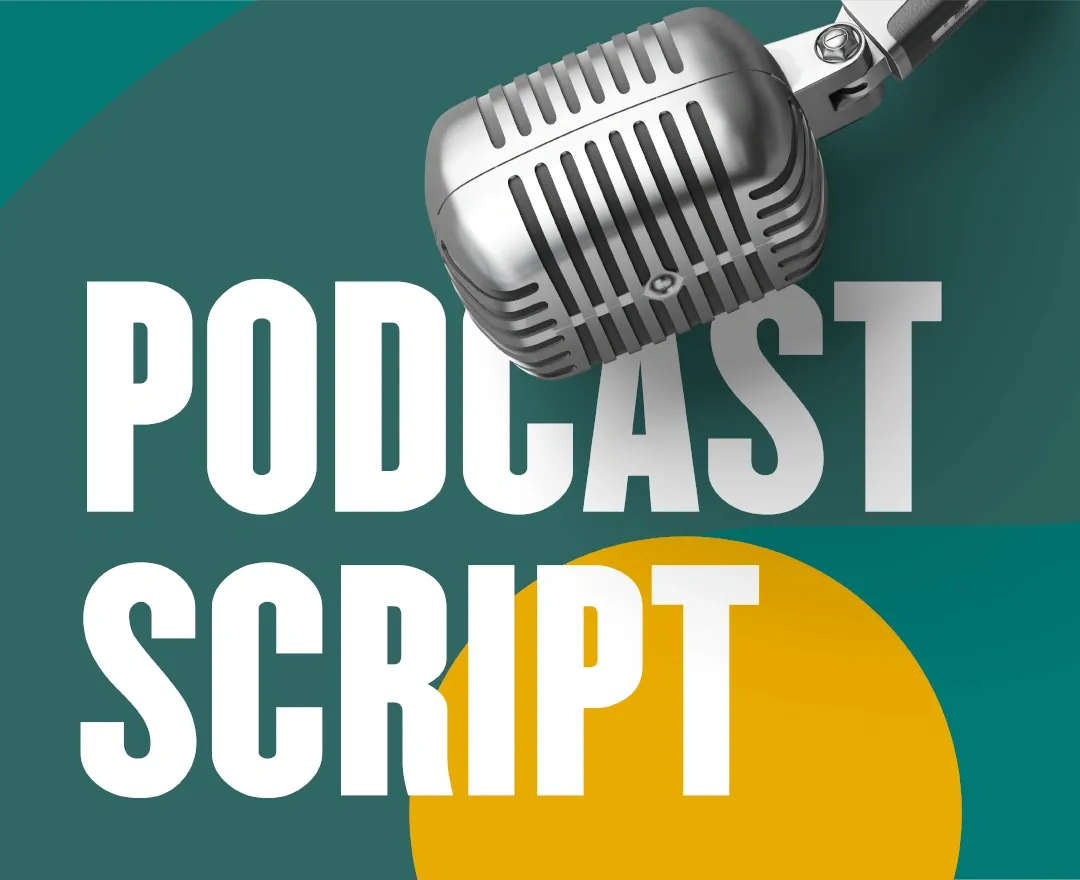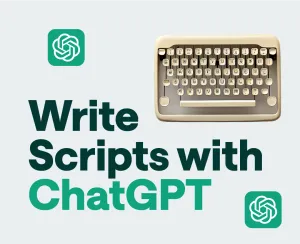Here's a little insider secret about podcasting: Those podcasts we love so much that feel entirely laid-back and spontaneous? Quite a few of them are actually choreographed behind the scenes with a carefully crafted script calling the shots.
As it turns out, even when you're following a super-detailed script, you can still make it sound like you're just having a relaxed chat.
A podcast script is the secret sauce that blends the best of different media—storytelling, conversation, and education—into one seamless and engaging piece of content. But, here's the kicker: there isn't a formula for a one-size-fits-all manuscript. It's a dynamic creation that evolves with your podcast format, episode structure, and subject matter.
Working with an easy and flexible podcast script template for your show will enable you to plot the direction of your episodes, design their flow, and ensure their effectiveness in reaching your audience. Most importantly, it grants you the confidence to focus on the recording itself, reducing the need for painstaking editing and rerecordings down the road.
What are the essentials of a podcast script?
First, let's briefly go over the various nuts and bolts that make up the anatomy of a podcast script. From the text that tells you what to say to the notations that tell you how to say it, these are the building blocks of a complete script.
1) Spoken Lines
At the heart of your podcast script lies the spoken content—the words, phrases, and sentences that weave your narrative together. This includes the host's narration, scripted dialogue, interviews, and monologues. The lines that are meant to be spoken are a script's foundation, giving it a shape and form that the other elements work to refine.
2) Delivery Notes
Delivery notes serve as directives for how the spoken content should be conveyed, encompassing elements like emphasis, tone, and specific instructions for delivery. By employing formatting or annotations within the script, you can enhance the clarity and impact of your podcast.
3) Cues
Cues in a podcast script are akin to stage directions in a play; they guide the timing and placement of sound effects, background music, transitions, and other audio elements. These cues help in orchestrating the auditory landscape of your podcast, ensuring an immersive listening experience.
Cues in your podcast script provide critical guidance to both hosts and production teams, ensuring that audio elements are seamlessly integrated to enhance storytelling and engagement. They serve as markers for when and where to incorporate these elements, creating a cohesive and polished listening experience for your audience.
4) Timestamps
In the world of podcasting, maintaining control over episode length is a key factor in keeping your audience engaged. Timestamps within your podcast script serve as a strategic tool to help you achieve this goal. By including estimated timestamps for each segment of your show, you gain the ability to structure and allocate time wisely, ensuring that your episodes align with your desired duration.
Podcast Script Templates
Now that we’re comfortable with the building blocks that make up a script, let’s look at each section of a podcast that can benefit from being scripted. We’ll go over the common elements that each section should contain, and then put those elements together in an example that you can plug your show’s particulars into for a no-sweat podcast script template!
1) The Podcast Introduction
The podcast intro is where you make your first impression, setting the stage for what's to come. It typically consists of four key elements:
Hook: A captivating and attention-grabbing statement or question that entices listeners.
Introduction of the Host or Hosts: Where you briefly introduce yourself or your team.
Guest Introduction (if applicable): Where you provide a short bio or context if you have a guest.
Show Notes with an Episode Title: Mention the episode title and any relevant information.
Template:
Put all together, a scripted intro that contains those elements would look something like this:
Introduction (Time: 00:01–_ _:_ _)
[CUE: Introduction Music/Podcast Theme]
Host: "Welcome to [Podcast Name], the show where [brief description of podcast purpose or theme]. I'm your host [Host Name], and I'm joined by my co-host [Co-host Name].
(Hook) "Now, before we dive into today's big topic, let's hit you with a little teaser. Have you ever wondered [Pose a thought-provoking question or present a teaser related to the episode topic]? Well, stick around because in this episode, we're going to unravel the mysteries behind [Episode Topic].
(Guest Intro): "But that's not all. We have a fantastic guest with us today, [Guest Name], who's an expert in [Guest's Expertise]. [Guest Name], welcome to the show.
(Show Notes and Episode Title): "And for those of you who like to follow along, today's episode is titled '[Episode Title].' You can find the show notes, links, and additional resources related to this episode on our website at [Website URL/Link]."
2) The Main Content
The main body of a podcast is where the real magic happens, and while your script plays a pivotal role in shaping this content, it’s also the place that has the fewest formal elements. The two organizing principles that make up the script for this section are:
Segments: These are discrete sections of the show centered on a specific topic, theme, or interview.
Transitions: These are verbal and sonic cues that help the host segue from one segment to the next without jarring shifts.
Template:
Because this is the section of a podcast that will have the most variation from show to show and even episode to episode, this template will need the most customization to work for your production. Remember, if a segment of your show contains an interview, you will want to impose a rough time limit for each question to ensure that you can get to all of your questions in the allotted time for the segment:
Main Content (Time: _ _:_ _–_ _:_ _)
Segment 1: Host Discussion (Time: _ _:_ _–_ _:_ _)
(Transition) Host: "Now that we've set the stage, let's dive into the topic of the day.
[CUE: Transition Music/Sound Effect]
(Segment) Host: "In this segment, we're going to explore [Introduction of Segment 1 Topic]."
…
(Transition) Host: “Now for a different perspective, let’s switch gears and listen to what our special guest, [Guest’s Name], has to say on this topic.”
[CUE: Transition Music/Sound Effect]
(Segment) Segment 2: Interview (Time: _ _:_ _–_ _:_ _)
Host: [Question #1] (Time: _ _:_ _–_ _:_ _)
Guest: [Answer]
Host: [Question #2] (Time: _ _:_ _–_ _:_ _)
Guest: [Answer]
3) The Sponsor Message
This is the part of your script that will require some collaboration!
Some sponsors might simply provide talking points, allowing room for your unique conversational style and approach. On the other side of the spectrum, sponsors may instead supply a fully pre-written segment for you to deliver on your show.
While this can save you time, it may risk feeling impersonal and uninteresting to your listeners, alienating them and causing them to resist the pitch you’re making. It's valuable to collaborate with your sponsor to develop a message that not only aligns with their goals but also genuinely resonates with your audience, enhancing the effectiveness of your sponsorship integration.
Template:
Ad Read for [Sponsor Name] (Time: _ _:_ _–_ _:_ _)
Host: "Before we continue, we'd like to take a moment to thank our sponsor for making this episode possible. Their support helps us bring you this content week after week.
"Today's episode is brought to you by [Sponsor Name], your go-to source for [Brief Description of Sponsor's Products or Services].
"With [Sponsor Name], you can [Highlight Key Benefits or Features of Sponsor's Products/Services].
(Call To Action) “If that sounds good to you, visit [Sponsor's Website/URL] and use promo code [Promo Code] for an exclusive [Discount/Deal/Offer]."
4) The Wrap-Up and Previews
The wrap-up and previews section of your podcast serves a dual purpose: to effectively close the current episode and provide a glimpse of what's on the horizon. Here's what this part of the script should contain:
Main Takeaways or Highlights: In the wrap-up portion, succinctly recap the key takeaways or highlights from the episode. This allows listeners to reinforce their understanding of the content and reinforces the value of your podcast.
Teaser or Preview of Future Episodes: Following the wrap-up, use this opportunity to tease or provide a brief preview of what's coming up in future episodes. This sparks anticipation and keeps your audience engaged, encouraging them to return for more.
Template:
Wrap-Up and Previews (Time: _ _:_ _–_ _:_ _)
(Takeaways and Highlights) Host: “We've covered a lot of ground today, discussing [Summarize Topics and Insights Discussed].
(Teaser and Preview) “While that may be it for this week, we’ve got some exciting content lined up for you in our upcoming episodes. Here’s a sneak peek of what’s on the horizon. [Teaser Highlights for Future Episodes].”
5) The Podcast Outro
The podcast outro is your opportunity to leave a lasting impression on your audience and establish connections beyond the episode. To effectively wrap up your podcast, your script for this section should include:
Closing Statement: Offer a closing statement expressing your sincere thanks to the audience for tuning in. Provide essential information on how they can connect with your podcast, such as your website, social media profiles, or email address.
Attributions and Acknowledgements: If your episode included references to individuals or sources, use this space to give credit where it's due. Recognize and appreciate any contributors, collaborators, or team members who played a role in creating the episode.
Call To Action (CTA): End your episode with a compelling Call To Action, encouraging your listeners to take specific actions. This might include subscribing to your podcast, leaving reviews, visiting your website, or engaging with your social media channels.
Template:
Outro (Time: _ _:_ _– 45:00)
(Closing Statement) Host: "And that's a wrap for today's episode. We want to extend our heartfelt gratitude to each and every one of you for tuning in and being a part of our [Podcast Name] community.
(Attributions and Acknowledgements) "Before we go, we'd like to give credit where it's due. A special thank you to [Acknowledgment 1], [Acknowledgment 2], and [Acknowledgment 3] for their valuable contributions to this episode. We're truly grateful for their insights and support.
(CTA) “We'd greatly appreciate your support in helping our podcast reach even more listeners. Here's how you can get involved:
1. Subscribe to [Podcast Name] on your favorite podcast platform so you never miss an episode.
2. Leave us a review on [Review Platforms] to let us know your thoughts and help others discover our show.
3. Visit our website and explore additional content, show notes, and resources related to today's episode.
4. Connect with us on [Social Media Platforms] to join the conversation, share your feedback, and stay up to date with our latest news and episodes.
"Thank you for being a part of our journey. Until next time, [Signature Closing Tagline]!"
Podcast Scripts for Students
If you’re a teacher, getting students to report on a subject in the form of a podcast can be a fun and creative assignment. Not only can it make learning more engaging, but it can also improve communication skills by encouraging students to explain complex ideas in a clear and interesting way–fostering critical thinking and digital literacy skills in the process.
A helpful podcast script template for students could look like this:
Introduction
Podcast Title: [Title of the Report]
Host(s): [Your Name or Names]
(Hook/Opening Statement) "Welcome to [Podcast Title], where we explore [Brief Description of Podcast Topic]. I'm your host, [Name]."
Segment 1 - Introduction to the Topic
(Brief Introduction of the Subject) "In this segment, we'll cover the subject of [Report Topic] from a few different perspectives."
(Why This Topic Matters) "But before we dive in, let's discuss why [Report Topic] is such a vital and intriguing subject…"
(Main Objectives/Questions) "Our goal today is to answer questions like [State the Main Objectives or Questions]."
Segment 2 - Main Content
(Exploring Key Points) "Now, let's delve into the heart of the matter and explore the key points that make [Report Topic] so fascinating…"
(Engagement Through Examples) "As an example of this, consider [Real-World Examples and Anecdotes]."
(Introduce and Interview Guest) “For more on this, here is my interview with [Guest’s Name and Credentials]...
Segment 3 - Student Reflection and Conclusion
(Recapping Key Points) "Before we wrap up, let's recap the main takeaways from today's discussion…"
(Sharing Personal Perspective) "When I first heard of [Report Subject], I thought that…But what I hadn’t considered was…The most interesting thing I learned turned out to be…"
(Prompting Further Discussion) "I'll leave you with a few questions to discuss in class…"
(Closing Statement and Final Thoughts) "Thank you for letting me take you on this journey through the world of [Report Topic]. Until next time, [Signature Closing Tagline]!"
This template provides a simple structured framework for students to create their podcast episodes, guiding them through the introduction, main content, and conclusion. It encourages engagement, reflection, and discussion and can be customized to fit their specific podcast topics and styles.








